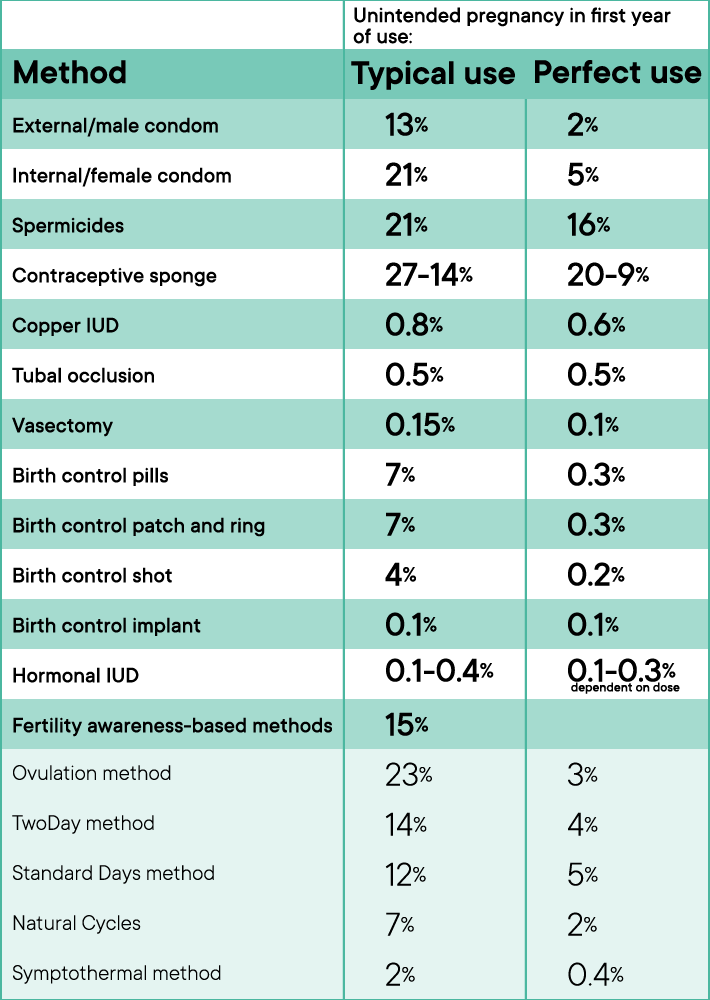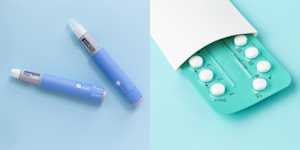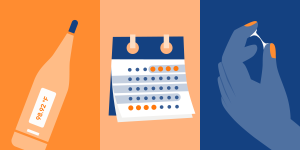Top things to know:
There are a variety of options when it comes to choosing a type of birth control.
Some birth control options have hormones and others don’t.
Each birth control method has risks and benefits.
It’s best to choose the birth control you’ll use correctly and consistently.

If you’ve decided you’re ready for birth control, you’ve definitely got options. Choosing a birth control can be overwhelming. But don’t panic—we’re here to help.
Birth control can be taken for a variety of reasons, including to manage irregular periods, reduce period cramps, or to skip periods altogether. For the purposes of this article, we’re going to be talking about birth control types used to prevent pregnancy.
Birth control without a prescription
Most forms of birth control require a prescription from a healthcare provider. But, when you need to be discrete or pick up some pregnancy prevention in a hurry, these options are available at most pharmacies without a prescription.
Condoms
Condoms are thin tubes of plastic, latex or other materials that cover the genitals to act as a barrier to bodily fluids. External or “male” condoms are very effective when used consistently and correctly. Although female/internal condoms are less popular, they can also be effective at preventing pregnancy when used correctly. As a bonus, consistent and correct use of condoms can also significantly reduce risk for STIs.
Condoms: common questions and misconceptions
How to use a condom: a step-by-step guide
Condom use from a female perspective
Spermicide creams, foams, and suppositories
Spermicides are considered some of the least effective forms of birth control, but are still better than using no protection at all. You can use spermicides in cream, foam, or suppository form with condoms, the cervical cap, and/or the diaphragm to make each method more effective. They work by immobilizing or destroying sperm. They work as soon as you apply them and you can have sex multiple times with the same use.
Contraceptive sponge
The contraceptive sponge is filled with spermicide and placed in the vagina before sex. The sponge must remain in the vagina for six hours after sex. The sponge is more effective if you’ve never been pregnant or if your pregnancy ended before 22 weeks. It works the same way spermicide does, but it has the added benefit of also absorbing ejaculate so it doesn’t enter the uterus.
Fertility Awareness Methods
Fertility Awareness-Based Methods (FAMs) can be used both to become pregnant and prevent pregnancy. FAMs are designed to predict when a person will ovulate and avoid sex when the fertilization of an egg is possible. There are a variety of FAM methods and each has a different efficacy rate. Some of these methods require more attention and effort than most other birth control methods.
Lactational amenorrhea is an effective form of birth control for postpartum people who exclusively breastfeed. This method requires breastfeeding (not pumping) every four hours during the day and every six hours at night. You can read all about other forms of non-hormonal birth control including outercourse and fertility awareness here.
Prescription birth control
In most places, these forms of birth control require a visit with a healthcare provider (either online or in-person) to obtain a prescription. The good news is that you can get your prescription that lasts from a year (for pills) to ten years (for the copper IUD) so you won’t have to worry about it again for a while unless you want to make a switch. Remember that none of these forms of birth control protect against STIs.
Non-hormonal birth control
The non-hormonal birth control options you can get from your healthcare provider include the copper IUD and sterilization.
Copper IUD
The copper IUD is hormone-free and can be used for 10 years. The IUD is a T-shaped plastic frame wrapped with a thin copper wire that releases copper ions. The copper IUD might increase menstrual pain and bleeding in some people, so it’s good to ask your provider if it’s the right option for you.
Sterilization
Permanent sterilization is the most effective form of birth control, but it’s only for people who don’t ever want to have more children. Both vasectomy (male sterilization) and tubal occlusion (female sterilization) require surgery, although it’s usually an outpatient procedure. Recovery from both procedures is usually quick.
Hormonal birth control
Hormonal birth control options include the implant, the intrauterine device (IUD), the shot, the pill, the ring, and the patch and they contain either progestin or a combination of both progestin and estrogen.
Most hormonal birth control prevents pregnancy by inhibiting ovulation, so there’s no egg to fertilize, or thickening cervical mucus to make it harder for sperm to enter the uterus. The hormonal IUD works differently. It mostly thickens cervical mucus so that sperm cannot fertilize an egg, and sometimes prevents ovulation but not always.
Here are all of your hormonal birth control options
Tracking with Clue if you’re on the hormonal birth control pill
How every method of hormonal birth control affects your period
How we think about birth control at Clue
Birth control pills
There are three types of pills with different variations of hormones:
The cyclic combination oral contraceptive (COC)
The extended use COC pill, which reduces or eliminates monthly bleeding
The progestin-only pill (POP), which is estrogen-free
Choosing a type of pill involves deciding on a few factors, including how often you want to have a period, and if you are breastfeeding/chestfeeding. Your provider can walk you through the best options for you.
Birth control patch and ring
The patch and ring both contain estrogen and progestin. Instead of taking a pill every day, however, the patch and ring can both be applied or inserted and left for a while.
The patch is made of thin plastic and looks similar to a small bandage. It delivers hormones through the skin and needs to be replaced weekly for three weeks, then skipped for one week.
The ring is a circular piece of plastic that’s placed in the vagina and left for three weeks, followed by one week during which no ring is used.
Birth control shot
The shot, or injectable contraceptive contains progestin. One dose lasts three months. Some people find this method very convenient. It’s also discrete and doesn’t require cooperation from sexual partners.
Birth control implant
The hormonal implant is the most effective form of hormonal birth control and contains only progestin. The implant is a thin rod that is inserted under the skin in the upper arm. It lasts for three years, at which point you can return to a clinic to have a new rod implanted. It’s convenient and also discrete.
Hormonal IUD
The IUD is a small T-shaped implant placed inside the uterus. The IUD is highly effective, convenient, discreet and has high rates of satisfaction among people who use it. There are a few different kinds of hormonal IUDs with varying doses of hormones. Depending on the dose, you can use one IUD for three to seven years. Your provider can help you pick the dose that works for you.
What it’s like to have a hormonal IUD
How do IUDs prevent pregnancy?
My IUD insertion: a kind-of boring story
One size does not fit all: my copper IUD experience
What it’s like to have a copper IUD
How to pick the right birth control
Choosing the birth control that’s right for you involves a few factors. Consider asking yourself the following:
Do you want to have monthly periods/withdrawal bleeding?
Do you want a method you can quit any day (like the pill) or one you can commit to (like the implant)?
Do you want a method you don’t have to think about?
Do you plan on becoming pregnant any time soon?
Do you need to hide your birth control use from anyone?
Do you want to address other cyclic issues like menstrual pain or heavy bleeding?
Each birth control method listed above has different risks and benefits. If you’re still not sure which one you’d prefer, take the above questions to your provider and go over your answers with them. You can use Clue to track your monthly bleeding and other symptoms before your visit to give your provider an overall picture of your cycle.



















